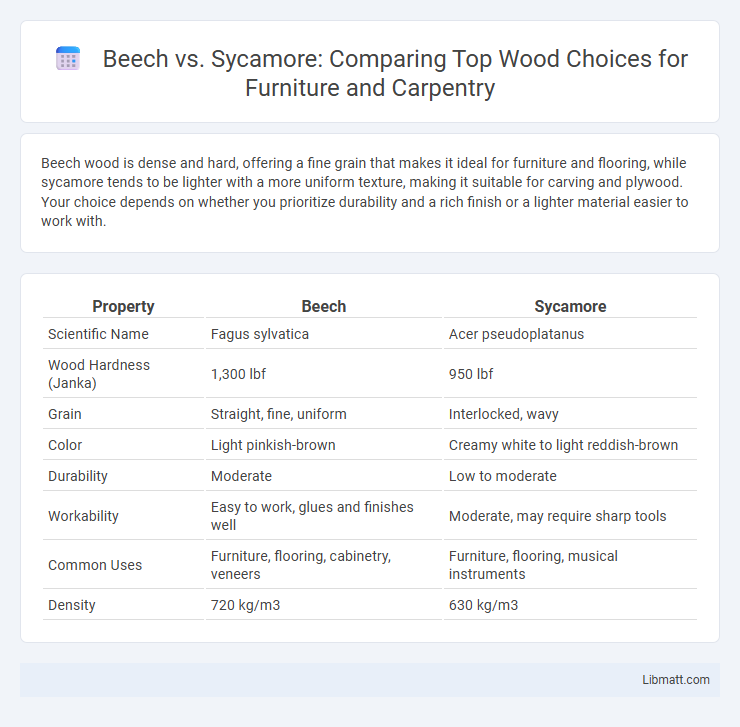Beech wood is dense and hard, offering a fine grain that makes it ideal for furniture and flooring, while sycamore tends to be lighter with a more uniform texture, making it suitable for carving and plywood. Your choice depends on whether you prioritize durability and a rich finish or a lighter material easier to work with.
Table of Comparison
| Property | Beech | Sycamore |
|---|---|---|
| Scientific Name | Fagus sylvatica | Acer pseudoplatanus |
| Wood Hardness (Janka) | 1,300 lbf | 950 lbf |
| Grain | Straight, fine, uniform | Interlocked, wavy |
| Color | Light pinkish-brown | Creamy white to light reddish-brown |
| Durability | Moderate | Low to moderate |
| Workability | Easy to work, glues and finishes well | Moderate, may require sharp tools |
| Common Uses | Furniture, flooring, cabinetry, veneers | Furniture, flooring, musical instruments |
| Density | 720 kg/m3 | 630 kg/m3 |
Introduction to Beech and Sycamore
Beech trees (genus Fagus) are known for their smooth, gray bark and dense, oval-shaped leaves, thriving in temperate climates across Europe, Asia, and North America. Sycamore trees (genus Platanus) feature distinctive exfoliating bark that reveals a patchwork of cream, green, and brown hues, with broad, lobed leaves adapted to various environments. Understanding these characteristics helps You differentiate between Beech and Sycamore, aiding in proper identification and care.
Botanical Classification and Origins
Beech trees (genus Fagus) belong to the family Fagaceae and are native to temperate regions of Europe, Asia, and North America, with species such as Fagus sylvatica common in Europe. Sycamore trees, often referring to Platanus occidentalis in North America or Acer pseudoplatanus in Europe, differ botanically; Platanus belongs to the family Platanaceae, while Acer is part of Sapindaceae, highlighting diverse evolutionary paths. These distinct botanical classifications reflect their varied origins, growth habits, and ecological adaptations across different continents.
Physical Appearance Comparison
Beech trees feature smooth, gray bark and dense, ovate leaves with pointed tips, while sycamore trees are characterized by their mottled, peeling bark revealing patches of white, green, and brown beneath. Beech leaves are smaller, generally 5-10 cm long with serrated edges, whereas sycamore leaves are larger, palmate with 3-5 lobes, often 10-20 cm wide. The overall form of beech trees is typically more compact and rounded, contrasting with the broad, spreading canopy of sycamores.
Growth Habits and Environmental Needs
Beech trees exhibit slow to moderate growth, preferring well-drained, fertile soils and partial to full sunlight, making them suitable for temperate climates with consistent moisture. Sycamore trees grow rapidly, thriving in a variety of soil types, including wet or poorly drained areas, and tolerate full sun to partial shade, often found along riverbanks and urban environments. Understanding these growth habits and environmental needs aids in selecting the appropriate species for landscaping, reforestation, or erosion control projects.
Wood Properties and Uses
Beech wood is hard, dense, and has a fine, tight grain, making it ideal for furniture, flooring, and kitchen utensils due to its durability and smooth finish. Sycamore wood is lighter and softer with a more open grain pattern, commonly used for carving, musical instruments, and decorative veneers because of its workability and attractive appearance. Both woods offer excellent shock resistance, but beech's hardness makes it better suited for heavy-duty applications, while sycamore excels in aesthetic and detailed woodworking projects.
Durability and Maintenance
Beech wood offers moderate durability, resistant to wear but vulnerable to moisture and insect damage, requiring regular sealing to maintain its integrity. Sycamore is less durable, prone to scratching and denting, and demands more frequent maintenance, such as refinishing and moisture control, to preserve its appearance. Your choice between beech and sycamore should consider the balance between their maintenance needs and durability for long-lasting performance.
Ecological Benefits and Wildlife Value
Beech trees provide dense canopy cover that supports diverse bird species and stabilizes soil with extensive root systems, enhancing forest ecosystems. Sycamore trees offer significant ecological benefits through their ability to tolerate wet soils and improve water quality by filtering pollutants, while their large leaves provide habitat and food for insects and mammals. Both species contribute to biodiversity but sycamores are especially valuable for riparian zones and floodplain habitats.
Common Pests and Diseases
Beech trees are susceptible to beech scale insects, beech bark disease, and powdery mildew, which can weaken the tree and cause bark deformities. Sycamore trees frequently suffer from sycamore lace bug infestations, anthracnose fungus causing leaf blotches, and canker diseases leading to branch dieback. Effective pest management and regular monitoring are essential to maintain the health of both beech and sycamore trees.
Landscaping and Garden Applications
Beech trees provide dense shade and smooth, attractive bark, making them ideal for formal gardens and shaded areas in landscaping. Sycamore trees offer broad canopies and rapid growth, suitable for creating windbreaks and providing substantial shade in larger garden spaces. Both species enhance garden aesthetics but differ in maintenance needs, with beech requiring less pruning compared to the often shedding sycamore.
Choosing Between Beech and Sycamore
Choosing between beech and sycamore hinges on your specific landscaping goals and climate conditions. Beech trees (Fagus species) offer dense foliage and smooth bark, thriving in cooler, well-drained soils, making them ideal for privacy screens and shade. Sycamore trees (Platanus species) grow faster, tolerate pollution better, and display striking peeling bark, suiting urban environments or large open spaces where rapid growth is desired.
Beech vs sycamore Infographic

 libmatt.com
libmatt.com